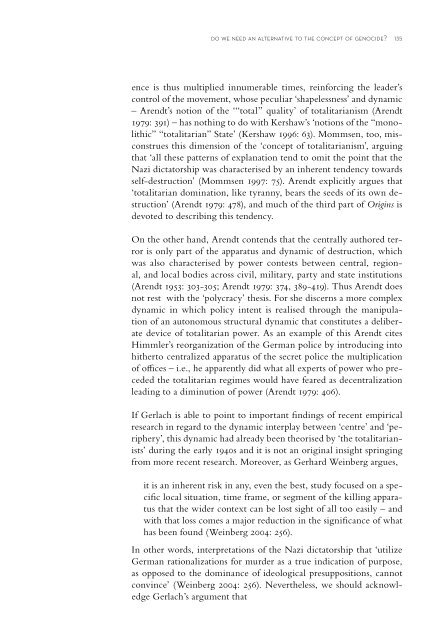60 years after the UN Convention - Dag Hammarskjöld Foundation
60 years after the UN Convention - Dag Hammarskjöld Foundation
60 years after the UN Convention - Dag Hammarskjöld Foundation
Create successful ePaper yourself
Turn your PDF publications into a flip-book with our unique Google optimized e-Paper software.
do we need an alternative to <strong>the</strong> concept of genocide? 135<br />
ence is thus multiplied innumerable times, reinforcing <strong>the</strong> leader’s<br />
control of <strong>the</strong> movement, whose peculiar ‘shapelessness’ and dynamic<br />
– Arendt’s notion of <strong>the</strong> ‘“total” quality’ of totalitarianism (Arendt<br />
1979: 391) – has nothing to do with Kershaw’s ‘notions of <strong>the</strong> “monolithic”<br />
“totalitarian” State’ (Kershaw 1996: 63). Mommsen, too, misconstrues<br />
this dimension of <strong>the</strong> ‘concept of totalitarianism’, arguing<br />
that ‘all <strong>the</strong>se patterns of explanation tend to omit <strong>the</strong> point that <strong>the</strong><br />
Nazi dictatorship was characterised by an inherent tendency towards<br />
self-destruction’ (Mommsen 1997: 75). Arendt explicitly argues that<br />
‘totalitarian domination, like tyranny, bears <strong>the</strong> seeds of its own destruction’<br />
(Arendt 1979: 478), and much of <strong>the</strong> third part of Origins is<br />
devoted to describing this tendency.<br />
On <strong>the</strong> o<strong>the</strong>r hand, Arendt contends that <strong>the</strong> centrally authored terror<br />
is only part of <strong>the</strong> apparatus and dynamic of destruction, which<br />
was also characterised by power contests between central, regional,<br />
and local bodies across civil, military, party and state institutions<br />
(Arendt 1953: 303-305; Arendt 1979: 374, 389-419). Thus Arendt does<br />
not rest with <strong>the</strong> ‘polycracy’ <strong>the</strong>sis. For she discerns a more complex<br />
dynamic in which policy intent is realised through <strong>the</strong> manipulation<br />
of an autonomous structural dynamic that constitutes a deliberate<br />
device of totalitarian power. As an example of this Arendt cites<br />
Himmler’s reorganization of <strong>the</strong> German police by introducing into<br />
hi<strong>the</strong>rto centralized apparatus of <strong>the</strong> secret police <strong>the</strong> multiplication<br />
of offi ces – i.e., he apparently did what all experts of power who preceded<br />
<strong>the</strong> totalitarian regimes would have feared as decentralization<br />
leading to a diminution of power (Arendt 1979: 406).<br />
If Gerlach is able to point to important fi ndings of recent empirical<br />
research in regard to <strong>the</strong> dynamic interplay between ‘centre’ and ‘periphery’,<br />
this dynamic had already been <strong>the</strong>orised by ‘<strong>the</strong> totalitarianists’<br />
during <strong>the</strong> early 1940s and it is not an original insight springing<br />
from more recent research. Moreover, as Gerhard Weinberg argues,<br />
it is an inherent risk in any, even <strong>the</strong> best, study focused on a specifi<br />
c local situation, time frame, or segment of <strong>the</strong> killing apparatus<br />
that <strong>the</strong> wider context can be lost sight of all too easily – and<br />
with that loss comes a major reduction in <strong>the</strong> signifi cance of what<br />
has been found (Weinberg 2004: 256).<br />
In o<strong>the</strong>r words, interpretations of <strong>the</strong> Nazi dictatorship that ‘utilize<br />
German rationalizations for murder as a true indication of purpose,<br />
as opposed to <strong>the</strong> dominance of ideological presuppositions, cannot<br />
convince’ (Weinberg 2004: 256). Never<strong>the</strong>less, we should acknowledge<br />
Gerlach’s argument that

















